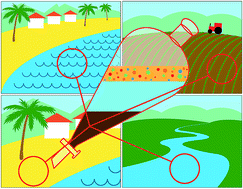Using castor oil to separate microplastics from four different environmental matrices†
Abstract
The detection of environmental microplastics (MP) is limited by the need to rigorously separate polymers from the surrounding sample matrix. Searching for an affordable, low-risk and quick separation method, we developed a protocol to separate microplastics (size range: 0.3–1 mm; virgin polymers: PP, PS, PMMA and PET-G) from suspended surface solids (marine and fluvial) as well as soil and sediment using castor oil. We demonstrate effective separation of the four polymers in a spike-recovery experiment. The mean ± SD MP spike-recovery rate was 99 ± 4% with an average matrix reduction of 95 ± 4% (dry weight, n = 16). The protocol was validated by separating non-spiked environmental Rhine River suspended solids samples recovering 74 ± 13% of MP. There PS comprised 76% of the non-retrieved MP and additional H2O2 digestion was needed to sufficiently reduce the highly abundant natural matrix. This castor oil lipophilicity-based protocol (i) achieves high MP recovery rates as a function of its environmental matrix reduction ability and (ii) provides environmentally friendly, non-hazardous and resource-efficient separation of MP from four different, typically investigated environmental compartments using one and the same method. Based on the Rhine River sample validation, the protocol is a potent replacement for traditional density separation techniques. Samples with high biogenic concentrations may require additional digestion.

- This article is part of the themed collection: Analytical Methods Recent Open Access Articles


 Please wait while we load your content...
Please wait while we load your content...